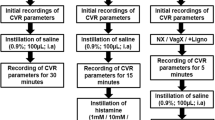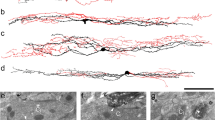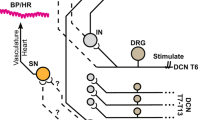Abstract
In hyperalgesic states, observed commonly as a major symptom of tissue inflammation or after central or peripheral nerve injury, non-noxious stimuli produce pain and noxious stimuli are perceived as more painful than usual. The mechanisms underlying the generation of hyperalgesia are not known. In patients with causalgia (burning pain and severe hyperalgesia after a nerve injury) activation of sympathetic post-ganglionic neurones or application of noradrenaline to painful skin exacerbates pain and hyperalgesia1 while sympathectomy may afford complete relief2. One suggestion is that noradrenaline released from sympathetic post-ganglionic neurones increases the discharge of damaged small-diameter afferents3,4 by a direct action on the primary afferents5,6. Here we present a new model for noradrenaline-sensitive hyperalgesia and demonstrate that the site of action of noradrenaline is not on the primary afferents but rather is presynaptic on the sympathetic post-ganglionic terminals.
This is a preview of subscription content, access via your institution
Access options
Subscribe to this journal
Receive 51 print issues and online access
$199.00 per year
only $3.90 per issue
Buy this article
- Purchase on Springer Link
- Instant access to full article PDF
Prices may be subject to local taxes which are calculated during checkout
Similar content being viewed by others
References
Wiesenfeld-Hallin, Z. & Hallin, R. G. Hum. Neurobiol. 3, 41–46 (1984).
Loh, L. & Nathan, P. W. J. Neurol. Neurosurg. Psychiat. 41, 664–671 (1978).
Wall, P. D. & Gutnick, M. Expl Neurol. 43, 580–593 (1974).
Devor, M. & Janig, W. Neurosci. Lett. 24, 43–47 (1981).
Devor, M. J. Autonom. Nerv. Sys. 7, 371–384 (1983).
Blumberg, H. & Janig, W. Pain 20, 335–354 (1984).
Randall, L. O. & Selitto, J. J. Arch. Int. Pharmacodyn. 3, 409–419 (1957).
Fitzgerald, M. J. T., Folan, J. C. & O'Brien, T. M. J. invest. Dermal. 64, 169–174 (1975).
Burnstock, G., Evans, B., Gannon, B. J., Heath, J. W. & James, V. Br. J. Pharmac. 43, 295–301 (1971).
Finch, L., Haeusler, G. & Thoenen, H. Br. J. Pharmac. 47, 249–260 (1973).
Starke, K., Wagner, J. & Schumann, H. J. Arch. Int. Pharmacodyn. 195, 291–308 (1977).
Stjarne, L. Acta physiol. scand. 86, 574–576 (1972).
Ramwell, P. W., Shaw, J. E. & Kucharski, J. Science 149, 1390–1391 (1965).
Westfall, T. C. Physiol Rev. 57, 659–728 (1977).
Juan, H. & Lembeck, F. Agents Actions 6, 642–645 (1976).
Wallin, B. G., Torebjork, E. & Hallin, R. G. in Sensory Functions of the Skin of Primates with Special Reference to Man (ed. Zotterman, Y.) 489–499 (Pergamon, Oxford, 1976).
Ferreira, S. H., Nakamura, M. & Salete de Abreu Castro, M. Prostaglandins 16, 31–37 (1978).
Devor, M. Pain 22, 127–137 (1985).
Author information
Authors and Affiliations
Rights and permissions
About this article
Cite this article
Levine, J., Taiwo, Y., Collins, S. et al. Noradrenaline hyperalgesia is mediated through interaction with sympathetic postgahglionic neurone terminals rather than activation of primary afferent nociceptors. Nature 323, 158–160 (1986). https://doi.org/10.1038/323158a0
Received:
Accepted:
Issue Date:
DOI: https://doi.org/10.1038/323158a0
This article is cited by
-
SMN deficiency causes pain hypersensitivity in a mild SMA mouse model through enhancing excitability of nociceptive dorsal root ganglion neurons
Scientific Reports (2019)
-
Effects of Post-Weaning Chronic Stress on Nociception, Spinal Cord μ-Opioid, and α2-Adrenergic Receptors Expression in Rats and Their Offspring
Journal of Molecular Neuroscience (2018)
-
Determination of inflammation of reflex sympathetic dystrophy at early stages with Tc-99m HIG scintigraphy: preliminary results
Rheumatology International (2006)
-
Influence of sympathetic nervous system on sensorimotor function: whiplash associated disorders (WAD) as a model
European Journal of Applied Physiology (2006)
-
Prostatitis’ epidemiology of inflammation
Current Urology Reports (2005)
Comments
By submitting a comment you agree to abide by our Terms and Community Guidelines. If you find something abusive or that does not comply with our terms or guidelines please flag it as inappropriate.



